CRAMBIDAE - Leucinodes orbonalis Guenée
Taxonomy
Pyraloidea: Crambidae: Spilomelinae: Leucinodes orbonalis Guenée
Common names: brinjal borer, eggplant borer, fruit and shoot borer
Larval diagnosis (Summary)
- SV group unisetose on A1
- Pigmented body pinacula
- Dark spot on D1 pinaculum of A2-8
- S1 posterior of a line connecting stemmata 2 and 3
- Mesothorax and metathorax with the MD and MSD1-2 setae on pigmented pinacula
- From the Old World on Solanum
Host/origin information
Most records of L. orbonalis in PestID are from Africa. These interceptions represent species in the L. orbonalis complex in Africa
which are not conspecific to the Asian populations of L. orbonalis. Interceptions of true L. orbonalis should originate from South Asia on Solanum.
| Origin |
Host(s) |
| South Asia | Solanum |
Recorded distribution
Leucinodes orbonalis is widely distributed throughout China, Nepal, India, Japan, Pakistan, Sri Lanka, and much of
Southeast Asia including Indonesia and the Philippines (Hayden et al. 2013).
Identification authority (Summary)
Larvae of L. orbonalis are recognized by having a combination of the morphological characters listed above. The origin must be Old World (South Asia) and
the host must be Solanum. Other similar species from Africa should be identified as "L. orbonalis complex."
Pest characterization
(Based on Cavey 2001, Hayden et al. 2013)
- Taxonomy: High. Species identification is often possible.
- Distribution: High. Leucinodes orbonalis is not present in the U.S.
- Potential Impact: High. Leucinodes orbonalis is a pest.
This ranking characterizes L. orbonalis as quarantine significant for the U.S.
CRAMBIDAE - Leucinodes orbonalis Guenée
Larval diagnosis (Detailed)
No complete description of L. orbonalis was found but several authors have partially described the larva. Mathur (1954) noted the SV group on A1 is
unisetose, the mandible has no inner teeth, and the spinneret is short. Capps (1963) also mentioned a unisetose SV group and separated Neoleucinoides elegantalis
from L. orbonalis by the pigmentation of the pinacula and position of the S1 seta. Weisman (1974) agreed that the pinacula pigmentation and setal position of
S1 varied between the two species. He added that the crochets of L. orbonalis are in a mesopenellipse. Later, Weisman (1986) used the unisetose SV group on
A1, crescent shaped prespiracular pinaculum, pigmented body pinacula, and presence of a dark spot on the anterior margin of D1 on A2-8 to identify L. orbonalis.
Further study showed this spot was unreliable as a character to separate all Neoleucinodes from all L. orbonalis. One problem is that some African specimens in the
L. orbonalis complex lack the spot whereas it is present in some specimens of Neoleucinodes from Central America and the West Indies (Whittle and Ferguson 1987).
As a result of these finds, it was APHIS policy not to record L. orbonalis from the New World unless it was based on adult captures, even if larvae keyed
to this species in Weisman (1986) (Steward [1987]). Solis (1999) used the presence of the dark spot as a character of both Neoleucinodes and Leucinodes,
later pointing out the spot can fade after preservation (Solis 2011). The SD1 pinacula of A2 and A7 are not reduced (SPIC) and SD1 is anterior to the spiracle
on A8 (Hayden et al. 2013). Whittle and Ferguson (1987) suggested further taxonomic work was needed and that Neoleucinodes and Leucinodes may not be distinct genera.
Figs. 9-11 are from a dissection of a specimen from Nigeria, thus these represent character states in the African "L. orbonalis complex." We know of no difference in
these structures from L. orbonalis in Asia. All other specimens figured are from the Philippines.
Identification authority (Detailed)
Typically, L. orbonalis is recognized by having a unisetose SV group on A1, pigmented body pinacula, a dark spot on D1 of A2-8, and S1 posterior of a
line connecting stemmata 2 and 3. Other characters include the mesothorax and metathorax with MD and MSD1-2 setae on pigmented pinacula (Solis 2011: couplet 33) and a unisetose L-group on A9.
The origin must be Old World and host must be Solanum. Records for Mangifera, Beta, Ipomoea, Pennisetum (Robinson et al. 2001),
Punica, chayote, and possibly Capsicum (Solis 2011) are suspect associations. Leucinodes orbonalis is widely distributed throughout China, Nepal, India, Japan,
Pakistan, Sri Lanka, and much of Southeast Asia including Indonesia and the Philippines (Hayden et al. 2013). Adults are not known from any New World locality (Solis 2011).
The unisetose SV group on A1, when present, seems to be very distinctive for recognizing Neoleucinodes and Leucinodes worldwide. It was used by Passoa (1985)
in Honduras for partially identifying Neoleucinodes. Other keys for Pyraustinae and Spilomelinae in the United States (Allyson 1981, 1984), Europe (Bollmann 1955), and Asia (Lin 1995)
do not even have a couplet for a unisetose condition. Instead, the included genera have a either bisetose or trisetose SV group on A1.
Variation in taxonomic characters of importance is a complicating factor. If the larva has a unisetose SV group on A1, and is from Africa on Solanum,
but lacks the dark spot on D1, it may be identified as "L. orbonalis complex." There are three species in this complex in Africa which are not conspecific
to the Asian populations of L. orbonalis (Hayden et al. 2013). Mathur (1954) noted variation in the SV setae on A2 for L. orbonalis in India and it is
likely similar variation will eventually be noticed on A1. If the larva is not unisetose on A1, even if it has a dark spot on D1, and is from Solanum
in the Old World, it should be left at subfamily Spilomelinae. Specimens with only one side of the larva unisetose, or with only a few D1 pinacula spotted,
can be evaluated on a case-by-case basis given the pathway and port experience with this group. Larva that do not have a unisetose SV group on A1, or any
spots on the D1 pinacula of A2-8, even if from Solanum, should be left at family unless the species-level identification is obvious from other characters.
Do not report L. orbonalis from New World interceptions based only on larvae - rear an adult or forward the specimen for molecular analysis.
Hayden et al. (2013) [see below] gave characters to separate L. orbonalis suspects from other solanaceous feeding pyraloids in the southeastern United States in
domestic surveys.
More information
Hayden, J. E., S. Lee, S. C. Passoa, J. Young, J.-F. Landry, V. Nazari, R. Mally, L. A. Somma, and K. M. Ahlmark. 2013.
Digital Identification of Microlepidoptera on Solanaceae. USDA-APHIS-PPQ Identification Technology Program (ITP). Fort Collins, CO.
CRAMBIDAE - Leucinodes orbonalis Guenée
Origin records
"Leucinodes orbonalis" has been intercepted from the following locations:
Angola, Argentina, Bangladesh, Benin, Bosnia and Herzegovina,
Brazil, Burundi, Cameroon, Cape Verde, China, Congo, Costa Rica, Cote D'Ivoire,
Ecuador, Egypt, El Salvador, Ethiopia, France (?), Gabon, Gambia, Germany, Ghana, Guatemala, Guinea, Haiti,
Honduras, Hong Kong, India, Indonesia, Israel, Jamaica (?), Jordan, Kenya, Laos, Liberia, Malaysia, Mali,
Morocco, Myanmar, Nepal, Netherlands, Niger, Nigeria, Philippines, Rwanda, Senegal,
Serbia and Montenegro, Sierra Leone, South Africa, South Korea, Sri Lanka, Sweden, Tanzania, Thailand, Togo,
Turkey, Uganda, United Kingdom of Great Britain and N. Ireland, Venezuela, Viet Nam, Zambia
Note that confirmed identifications of L. orbonalis should originate from South Asia on Solanum. Other origins and hosts listed here are questionable or represent
other species. There are three species in the L. orbonalis complex in Africa that are not conspecific with the Asian species.
Host records
"Leucinodes orbonalis" has been intercepted on the following hosts:
Abelmoschus esculentus, Amaranthus spinosus, Astilbe sp., Capsicum annuum, Capsicum sp.,
Castanea mollissima, Cola acuminata, Cola nitida, Corchorus capsularis, Cucurbita maxima,
Cucurbita sp., Cucurbitaceae, Dioscorea sp., Erythrina sp., Fabaceae, Gnetum africanum,
Lagenaria siceraria, Lamiaceae, Limonia acidissima, Lycopersicon sp., Malus sp., Malvaceae,
Mangifera sp., Myristica fragrans, Persea americana, Phaseolus sp.,
Phaseolus vulgaris, Pithecellobium dulce, Psidium guajava, Pterocarpus sp.,
Punica sp., Pyrus sp., Sapodilla sp., Solanaceae, Solanum aethiopicum, Solanum berejena,
Solanum betaceum, Solanum integrifolium, Solanum lycopersicum var lycopersicum,
Solanum macrocarpon, Solanum melongena, Solanum melongena var. esculentum, Solanum quitoense,
Solanum sp., Solanum torvum, Solanum tuberosum,
Vernonia amygdalina, Zea mays
Any host not in the Solanaceae requires confirmation.
CRAMBIDAE - Leucinodes orbonalis Guenée
Setal map
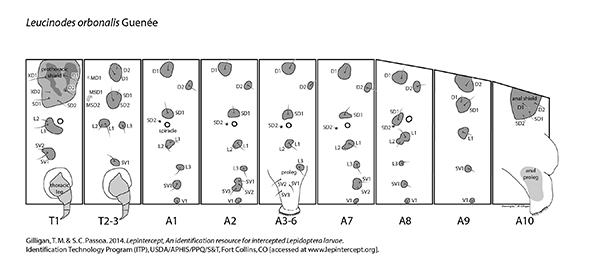 Leucinodes orbonalis setal map Leucinodes orbonalis setal map
<< Previous fact sheet Next fact sheet >>
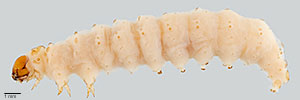 Fig. 1: Late instar, lateral view
Fig. 1: Late instar, lateral view |
 Fig. 2: Late instar, lateral view
Fig. 2: Late instar, lateral view |
 Fig. 3: Early instar, lateral view
Fig. 3: Early instar, lateral view |
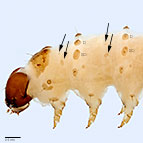 Fig. 4: Mesothorax and metathorax with the MD and MSD1-2 setae on pigmented pinacula
Fig. 4: T2-3 |
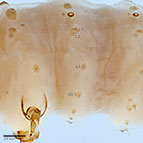 Fig. 5: Unisetose SV group on A1
Fig. 5: SV group on A1 |
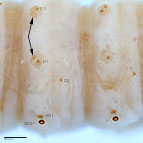 Fig. 6: Dark spot(s) on D1 of A2-8
Fig. 6: D1 on A2-8 |
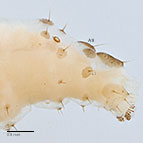 Fig. 7: Unisetose L-group on A9
Fig. 7: L-group on A9 |
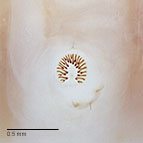
Fig. 8: Crochets |

Fig. 9: Head |
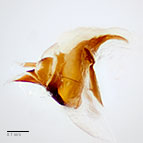 Fig. 10: Hypopharyngeal complex, lateral view
Fig. 10: Hypo. complex |

Fig. 11: Mandible |
|
|
|
|
|